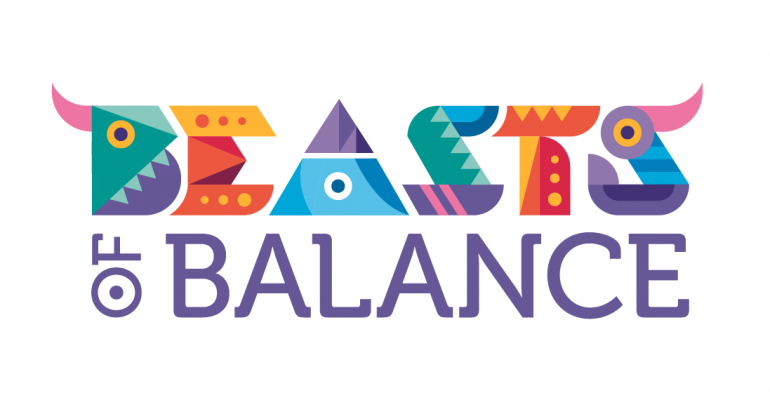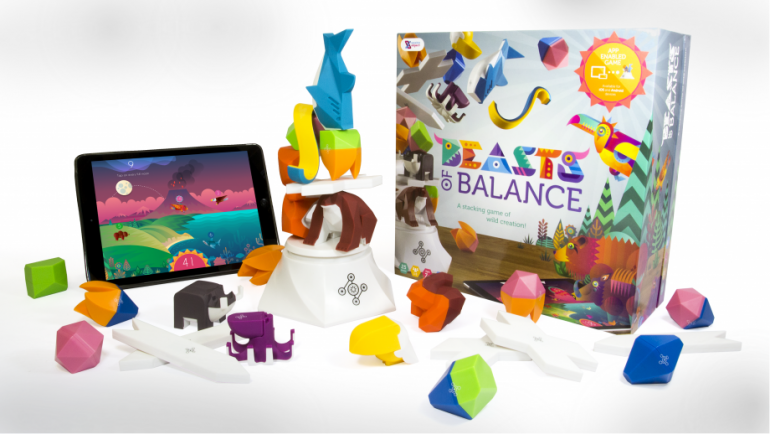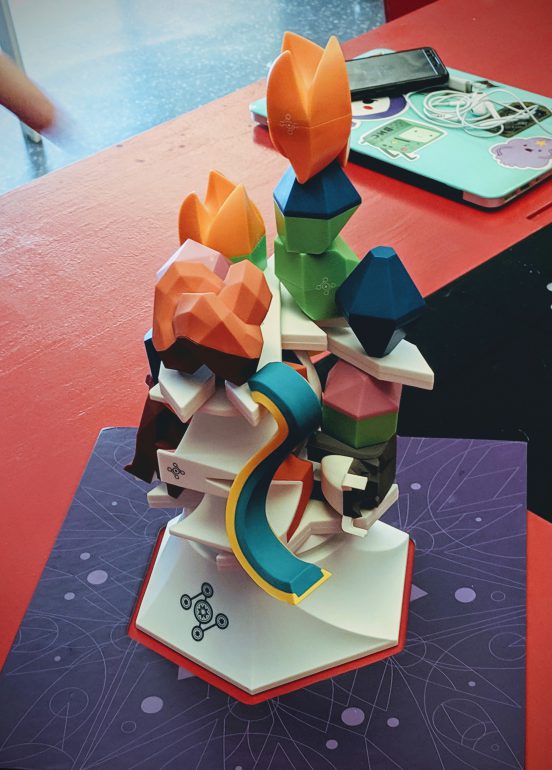
When cracking open the box for Beasts of Balance, two things quickly become apparent.
First, it is immediately obvious that the physical elements of the game have been constructed lovingly. The box contains half a dozen animals, a collection of abstracted elemental pieces, and two sets of platforms — all beautifully molded out of lightweight plastic. The aesthetic for Beasts of Balance seems to be that of faux-origami, with the game pieces boasting broad flat edges, symmetrical designs, and two-toned colour palettes. The result is a set of objects that, if separated from their game context, could be sold as designer toys.
Secondly, once one has sifted through the game pieces themselves, the game box is surprisingly empty. There is no instruction booklet for Beasts of Balance, save for a rather concise pamphlet that directs players to: a) put batteries in the plinth (a white platform that serves as the focus of the game), and b) download the official app on their cell phone or tablet. That’s it! Much like XCOM: The Board Game, Beasts of Balance relies entirely on a free app to run the game, alongside bluetooth connectivity facilitate player turns. It’s a digital, battery operated experience!

In terms of gameplay, Beasts of Balance is essentially a cooperative, augmented reality version of Jenga. Instead of stacking wooden blocks, players position plastic artefacts that trigger effects within a digital world simulated by the game’s app. The world is split into three main areas — air, earth, and water — with a large volcano looming ominously in the background. The artefacts are split into several categories, which trigger the following effects:
- Beast Artefacts cause animals to spawn in the game world. Placing the bear artefact on the plinth, for example, spawns a bear in the earth area. Animals are worth points based on their size, but lose points if they share an area with a more valuable creature (they get jealous!).
- Element Artefacts, which consist or either one or two elements — earth, wind, water, fire. These artefacts grant additional points to all animals in a certain area, save for the fire artefact, whose points can be directed toward a specific animal.
- Cross Artefacts and Migrate Artefacts, which are used to create hybrid animals by cross-breeding them or adapting them to different environments. In addition to adding new types of animals to the game world, these hybrid animals are generally worth more points than the default beasts.
- A Distraction Artefact and a Haste Artefact, both of which add challenges to the game that, when completed, generate more points for the players.
Unlike Jenga, which inevitably ends with a single “loser,” Beasts of Balance employs a rather complex, cooperative scoring system. The order in which elements are placed on the plinth is vital, both for balancing the tower and for scoring points. If a beast loses all of its points, it dies! Knowing the proper time to play certain artefacts — such as creating a hybrid animal or adding more water artefacts to the field — is incredibly important. However, as the app takes care of all the point calculations for the players, it can sometimes be difficult to figure out the optimal ways to score. My group was pretty content after our third game of Beasts of Balance, having utilized every single piece without toppling the tower, only to learn that our score of 180 paled in comparison to the 1000+ scores that veteran players regularly rack up. The opacity of the game’s scoring system could be frustrating for more competitive gamers, although perhaps I should be mindful that this is, indeed, a family-oriented game.

Photo Credit – Gina Haraszti
As for toppling the tower… it is definitely less of a zero-sum game than Jenga. Rather than losing the game outright due to a stacking miscue, players have a short window of time to rebuild before triggering a game over. Spurred on by the rumbling of a volcano, players must scramble to gather up their fallen pieces to avoid a cataclysmic eruption. As the game tracks the weight of the pieces on the plinth (and not the order in which they are stacked), a partial collapse is not always unwelcome. Being able to rearrange pieces can salvage a tower that was, perhaps, a bit architecturally unsound to begin with.
After a few sessions of Beasts of Balance, my boardgame group felt that we were just beginning to scratch the surface of the game. At times, this was a bit frustrating, as there didn’t seem to be a clear path toward game mastery. The Beasts of Balance website proclaims that “there’s no right or wrong way to play the game,” but ambitious players may desire a bit more information on how the scoring works. For the most part, however, the depth of the game simply creates the feeling that there is always more content to discover. There’s a certain joy in creating new types of hybrid animals and finding effective ways to keep your bizarre chimeras happy. And at the very least, those who grew up with Jenga will find satisfaction in stacking blocks sky-high before seeing them tumble to the ground.
